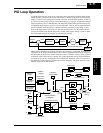
SJ300 Inverter
Operations
and Monitoring
4–69
If the auto-tuning procedure is successful, the inverter updates
the motor characteristic parameters and indicates normal termi-
nation of the procedure as shown. Pressing any key on the
keypad will clear the result from the display.
• Trip during auto-tuning – A trip event will cause the auto-
tuning sequence to quit. The display will show the error code
for the trip rather than the abnormal termination indication.
After eliminating the cause of the trip, then conduct the auto-
tuning procedure again.
• Power loss or stop during auto-tuning – If the auto-tuning
procedure is interrupted by power loss, the Stop key, or by
turning OFF the Run command, the auto-tuning constants
may or may not be stored in the inverter. It will be necessary to restore the inverter’s factory
default settings (see “
Restoring Factory Default Settings” on page 6–9). After initializing the
inverter, then perform the auto-tuning procedure again.
• Free V/F setting – The auto-tuning procedure will have an abnormal termination if the
control mode of the inverter is set for free V/F setting.
Adaptive Auto-
tuning of Motor
Constants
The adaptive auto-tuning feature refines the motor constants by checking the motor characteris-
tic while it in the normal running temperature range.
Preparation for Adaptive Auto-tuning – Be sure to study the preparation items and verify the
related inverter configuration before going further in this procedure.
1. It is necessary to first perform the auto-tuning procedure in the section above, since adaptive
auto-tuning requires accurate initial constant values.
2. Adaptive auto-tuning is valid only for the 1st motor data (do not use 2nd or 3rd motor data
settings).
3. The adaptive auto-tuning sequence actually begins as the motor decelerates to a stop from a
Run command you initiate. However, the sequence still continues for five (5) more seconds.
Giving another Run command during this 5-second time period will halt the adaptive auto-
tuning. It will resume the next time the motor runs and decelerates to a stop.
4. If DC braking is enabled, then the adaptive auto-tuning sequence executes after DC braking
brings the motor to a stop.
After reading and following the preparation steps above, then configure the inverter for
adaptive auto-tuning by following these steps:
1. Set H002=02 for adaptive auto-tuning procedure
2. Set H001=00 to disable the (manual) auto-tuning procedure
3. Turn the Run command ON.
4. Run the motor for an appropriate time until it reaches its normal operating temperature
range. Remember that the purpose of adaptive auto-tuning is optimize the inverter for
typical running conditions.
5. Stop the motor (or turn the Run command OFF), which initiates an adaptive auto-tuning.
Wait at least five (5) seconds before issuing any other command to the inverter.
With the above configuration, the inverter automatically runs the adaptive auto-tuning sequence
each time the motor runs and decelerates to a stop. This continuously adapts the SLV control
algorithm to slight changes in the motor constants during operation.
NOTE: It is not necessary to wait 5 seconds after each time the motor runs before running
again. When the motor stops for less than 5 seconds before running again, the inverter stops the
adaptive tuning sequence and keeps the current motor constant values in memory. The inverter
will attempt the adaptive auto-tuning at the next run/stop event of the motor.
Abnormal termination
Normal termination


















